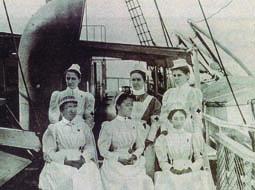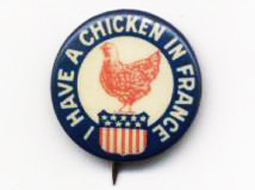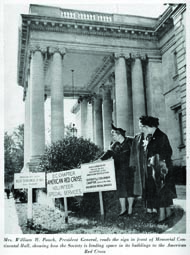Celebrate 125! Monday: Daughters Aid in War Recovery

Throughout its history, the DAR has worked to support active duty military personnel, and also to provide relief to those affected by armed conflict. This sampling of the National Society’s wartime service work demonstrates Daughters’ willingness to tailor their efforts to fit the situation.
When the Spanish-American War broke out in 1898, the DAR had not yet reached its eighth anniversary. Nevertheless, at the request of General George M. Sternberg, the Surgeon General of the Army, Daughters mobilized to provide nurses to treat soldiers wounded in the conflict. Through the DAR Hospital Corps, directed by Dr. Anita Newcomb McGee, the National Society certified more than 1,000 trained nurses for service at the front.
 During World War I, one of the National Society’s less conventional relief efforts was its campaign to “rechickenize” France in the wake of the country’s poultry shortage. Daughters collected dimes and quarters for the cause and in return gave contributors buttons reading “I have a chicken in France.” The DAR also raised funds to restore the village of Tilloloy, which was damaged by heavy fighting. President General Sarah Guernsey visited Tilloloy in 1919 to see the rebuilt infrastructure, newly constructed homes and other improvements funded by Daughters’ donations.
During World War I, one of the National Society’s less conventional relief efforts was its campaign to “rechickenize” France in the wake of the country’s poultry shortage. Daughters collected dimes and quarters for the cause and in return gave contributors buttons reading “I have a chicken in France.” The DAR also raised funds to restore the village of Tilloloy, which was damaged by heavy fighting. President General Sarah Guernsey visited Tilloloy in 1919 to see the rebuilt infrastructure, newly constructed homes and other improvements funded by Daughters’ donations.
DAR gave the American Red Cross the free use of any and all available space in Constitution Hall during World War II. Cumulatively, 112,000 DAR members performed more than 26 million hours of volunteer service for Red Cross operations, and purchased $69 million in war bonds and stamps. Daughters also helped buy ambulances, trucks and mobile canteens desperately needed in war zones.
 In January 1968, President General Adele Sullivan traveled to Vietnam to visit U.S. troops in an active combat area. During the trip Mrs. Sullivan kept a journal, which is now part of the NSDAR Archives. Foreshadowing the Tet Offensive, in an entry dated January 26, 1968, she explains that U.S. forces were expecting increased action prior to the celebration of Tet. Mrs. Sullivan notes, “Transported by ‘chopper’ with machine guns on each side from Camp Enari to a small hill called Pleiku, where 230 members of the 1st Battalion were entrenched and where three Viet Cong had been discovered earlier in the day. … En route we passed over artillery fire twice and special caution was taken as we landed.”
In January 1968, President General Adele Sullivan traveled to Vietnam to visit U.S. troops in an active combat area. During the trip Mrs. Sullivan kept a journal, which is now part of the NSDAR Archives. Foreshadowing the Tet Offensive, in an entry dated January 26, 1968, she explains that U.S. forces were expecting increased action prior to the celebration of Tet. Mrs. Sullivan notes, “Transported by ‘chopper’ with machine guns on each side from Camp Enari to a small hill called Pleiku, where 230 members of the 1st Battalion were entrenched and where three Viet Cong had been discovered earlier in the day. … En route we passed over artillery fire twice and special caution was taken as we landed.”
This is a Quasquicentennial Flashback article that was featured in the May/June 2015 American Spirit magazine. Subscribe to the magazine here: www.dar.org/subscribe.


 Today's DAR
Today's DAR